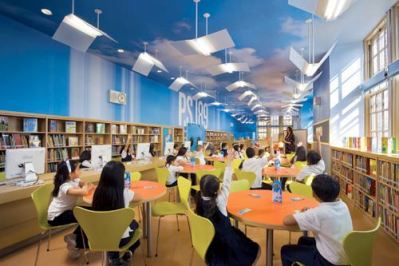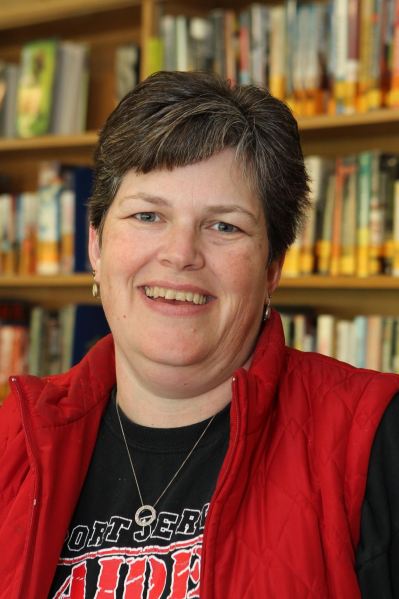Building the Learning Environment: Facility
Update December 2020:
This web page is a companion to the 2016 version of the School Library Program Rubric. NYSED released an updated School Library Program Rubric in December 2020.
Student Snapshot: The library media center facility is conducive to learning and designed to meet every student’s needs.
IFLA School Libraries Standing Committee (2015) state “a school library is a school’s physical and digital learning space where reading, inquiry, research, thinking, imagination, and creativity are central to students’ information-to knowledge journey, and to their personal, social and cultural growth. A school library operates as:
- a dedicated physical and digital space in a school that is open and accessible to all.
- an information space providing equitable and open access to quality information sources across all media, including print, multimedia and curated digital collections.
- a safe space where individual curiosity, creativity and an orientation toward learning are encouraged and supported and where students can explore diverse topics, even controversial topics, in privacy and safety.
- an instructional space where students learn the capabilities and dispositions for engaging with information and for creating knowledge.
- a technological space providing a diverse range of technology tools, software and expertise for the creation, representation and sharing of knowledge.
- a literacy center where the school community nurtures reading and literacy development in all its forms.
- a center for digital citizenship where the learning community learns to use digital tools appropriately, ethically and safely, and learns strategies to protect identity and personal information.
- an information environment for all in the community through equitable access to resources, technology, and information skills development that are not always available in homes. a social space open for cultural, professional and educational events (e.g., events, meetings, exhibits, resources) for the general community.”
Source: IFLA School Libraries Standing Committee. “The IFLA School Library Guidelines.” Jan 2015.
Citation for Photo: Vercerka, Albert. 2011, P.S. 189, Manhattan, New York. School Library Journal.
In Practice
From Drab to Fab: The Tale of a Crafty Librarian and Her Quest to Create a 21st century Learning Environment
Description: A school librarian’s story about how she transformed her school library by creating a space that fostered a 21st century learning environment.
Resource/Citation: Gilcreast, Jessica. "From drab to fab: the tale of a crafty librarian and her quest to create a 21st century learning environment." Knowledge Quest, vol. 42, no. 4, 2014, pp. 38-43.
Library X-Gen: Student Centered Spaces
Description: In this article, a school librarian shares the story on how she transformed her school library by employing the learning commons model.
Resource/Citation: Turner, Heather. "Library X-Gen: Student Centered Spaces." Knowledge Quest, vol. 42, no.4, 2014, pp. 28-31.
Learning Standards & Program Guidelines Implementation Toolkit
Description: This toolkit includes Empowering Learners: Guidelines for School Library Programs, which discusses program and facilities management. Consider how realigning your program management goals and transforming your physical space will accommodate the robust new learning model.
Resource/Citation: American Association of School Librarians. "Learning Standards & Program Guidelines Implementation Toolkit." American Association of School Librarians, 2015.
From Library to Learning Commons: Our Crescent Heights High School Experience
Description: A school librarian shares her experience transitioning the space in her library to a responsive, flexible, innovative and collaborative student-centered hub in her school.
Resource/Citation: Mueller, Lisa. "From library to learning commons: our Crescent Heights High School Experience." Teacher Librarian, vol. 43, no.1, 2015, pp. 12.
In Theory
High Impact School Library Spaces Envisioning New School Library Concepts
Description: This book provides a key weapon in the fight for the survival of school libraries, explaining how the future depends on designing and implementing multimodal learning spaces.
*Resource/Citation: Sullivan, Margaret L. High Impact School Library Spaces Envisioning New School Library Concept. Libraries Unlimited, 2015.
Arranging a Library to Support Adolescent Development
Description: When designing a school library space and deciding how to arrange resources, it is important to consider multiple components of adolescent development, including social, emotional, and behavioral aspects. Acknowledging these developmental facets and their importance can provide additional justification for some of the more controversial aspects of modern school library spaces, like gaming tables, lounge seating, and areas devoted to resources related to teen issues. Supporting all areas of adolescent development may provide convincing justification librarians can use in schools where administrators are slow to warm to more enlightened models of a modern school library program.
Resource/Citation: Cesari, Lindsay. "Arranging A Library To Support Adolescent Development." Knowledge Quest, vol. 42, no.4, 2014, pp. 44-48.
Redesigning Our Role While Redesigning Our Libraries
Description: The article presents the author's views on the need for redesigning school libraries in the U.S. It states that gradually student are reducing their use of school libraries. Degrading school library programs are being seen as one of the prominent reasons behind this. Therefore, their redesigning should be effective enough to get into the core of the problem.
Citation: Bradburn, Frances Bryant. "Redesigning Our Role While Redesigning Our Libraries." Knowledge Quest, vol.42, no.1, 2013, pp. 52-5.
Library Spaces, Library Faces
Description: The released Knowledge Quest issue provides information on how physical and virtual space can be maximized in school libraries.
Citation: Dickinson, Gail K. "Library Spaces, Library Faces." Knowledge Quest, vol. 42, no.4 2014, pp. 4-5.
Library Spaces for 21st-Century Learners: A Planning Guide for Creating New School Library Concepts
Description: Library Spaces for 21st-Century Learners: A Planning Guide for Creating New School Library Concepts focuses on planning contemporary school library spaces with user-based design strategies. The book walks school librarians and administrators through the process of gathering information from students and other stakeholders involved in planning a resource rich learning space. Information includes how to create needs assessment documents that complement AASL’s Empowering Learners: Guidelines for School Library Programs. Suggestions for adding meaningful esthetic components and colorful renderings of sample environments are also provided.
Resource/Citation: Sullivan, Margaret. “Library Spaces for 21st-Century Learners: A Planning Guide for Creating New School Library Concepts.” American Association of School Librarians, 2013.
Bridging Two Worlds: Moving from Repository to Learning Spaces
Description: An article sharing how learning commons foster a culture of innovation.
Citation: Johnson, Kathleen. "Bridging two worlds: moving from repository to learning spaces." Teacher Librarian, vol. 43, no. 3, 2016, p. 19.
Consultant
Name: Lisa Perkowski
Email: lperkowski@pjschools.org
Bio: Lisa Perkowski is the high school librarian and k-12 library coordinator in the Port Jervis City School District. She is past president of the School Librarians of Southeastern New York (SLMSSENY) and a long time executive board member of the New York Library Association’s Section of School Librarians (NYLA/SSL).
*To access restricted database articles speak with your school librarian or public librarian.







